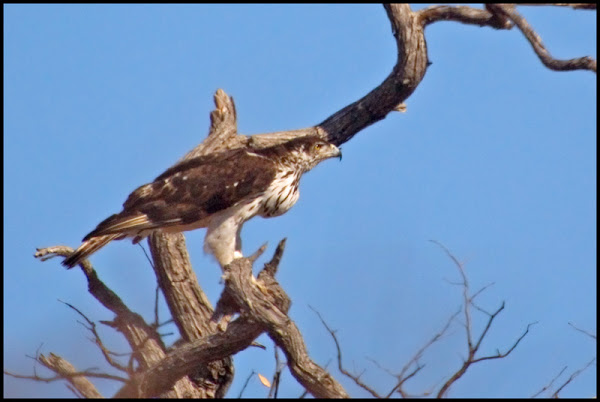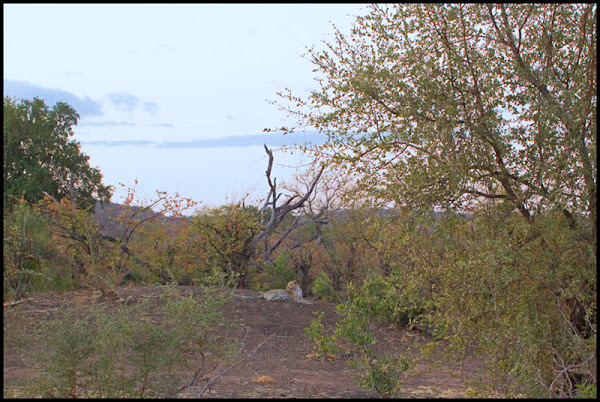Etapas del viaje / Trip sections:
El 24 de agosto iba a ser nuestro último día en el Parque Nacional Kruger. La zona más cercana a Mopani se caracterizó por un paisaje muy seco, con poca vegetación, hasta que nos acercamos al río Shingwedzi y al campamento con su mismo nombre. La cercanía del río, aunque con poca agua, hizo aflorar un buen número de especies. En esta zona fue en la única en la que pudimos ver al Topi, un antílope parecido al bontebok que observamos cerca de Ciudad de El Cabo.
August 24th was our last day in the Kruger National Park. The area closest to Mopani was characterized by a very dry landscape, with little vegetation, until we approached the Shingwedzi river and the associated camp. The proximity of the river, although with not too much water, brought out a good number of species. This was the only area within the park where we saw western tsessebe, an antelope similar to the bontebok that we observed near Cape Town.
La crónica completa del viaje en eBird, incluyendo el mapa y la lista de aves observadas, se puede obtener pinchando en este enlace.
The complete eBird trip report, including map and the list of bird species can be seen in this link.
South Africa map. Location 15 corresponds to Kruger National Park.
Además de los topis, pudimos ver un manada relativamente grande de leones, junto a los antílopes habituales (impalas, ñúes, cebras, bushbuck, nialas, kob acuático, etc), hipopótamos, elefantes y jirafas. Entre las aves, hay que destacar el único ejemplar de cálao terrestre sureño. También un ejemplar hembra o inmaduro de viuda senegalesa (si no voy errado con la identificación).
In addition to western tsessebe, we were able to see a relatively large herd of lions, along with the usual antelopes (impalas, wildebeests, zebras, bushbuck, nyalas, Ellipsen waterbuck, etc.), hippos, elephants, and giraffes. Among the birds, I have to highlight our only southern ground-hornbill. Also a female or immature of village indigobird (if I am correct with the identification).
Kruger National Park map and area explored on August 24th, 2019.
Salimos de Mopani tras echar, primero, un vistazo desde el mismo campamento a la Pioneer Dam, para recorrer la carretera S50. Esta ruta se caracteriza por su ambiente seco hasta llegar al río Shingwedzi. Desde allí, llegamos al campamento Shingwedzi para luego dirigirnos hasta Punda Maria recorriendo primero la carretera S56 que sigue el curso del río Mphongolo. Una vez en Punda Maria, y ya cuando caía el sol, recorrí la S99 (Mahonie Loop). Esta última me deparaba una grata sorpresa para finalizar nuestra visita a este gran parque nacional.
We left Mopani Camp, after taking a look from the same camp at the Pioneer Dam, to drive through the S50 road. This route is characterized by its dry landscape until reaching the Shingwedzi River. From there, we arrived to the Shingwedzi camp and then we head to Punda Maria Camp. But first, we took the S56 road that follows the course of the Mphongolo River. Once in Punda Maria, and before sunset, I drove the S99 (Mahonie Loop). The latter gave me a pleasant surprise to end our visit to this great national park.
Route on August 23th, 2019.
1. Entre Mopani y Shingwedzi / Between Mopani and Shingwedzi.
La primera parte se caracterizó por su poca vegetación hasta llegar al río Shingwedzi. Como punto destacado, merece la pena visitar la Grootvlei Dam, con algunos limícolas y varias especies de rapaces.
The first part was characterized by its lack of vegetation until we reached the Shingwedzi River. As a highlight, the Grootvlei Dam is worth a visit, as it contained several plovers and various species of raptors.
Centro: Cigüeñuela común / Center: Black-winged stilt (Himantopus himantopus)
Derecha: Chorlitejo tricollar / Right: African three-banded plover (Thinornis tricollaris)
Ya en el río Shingwedzi empezaron a aparecer los antílopes, incluyendo los primeros topis, y algunos grupos de aves, entre los que destacó una posible hembra o inmaduro de viuda senegalesa. También un jabirú africano.
As we approached the Shingwedzi river, we began to see several antelopes, including our first western tsessebes. Also some groups of birds, including a possible female or immature village indigobird. Also a saddlebill.
Bajamos a estirar las piernas en el Shingwedzi Camp. Allí, entre las diferentes viviendas, un impresionante varano de garganta blanca.
We stopped at the Shingwedzi Camp. There, and between the different houses, there was an impressive white-throated monitor.
2. Entre Shingwedzi y Punda Maria / Between Shingwedzi and Punda Maria.
Seguir el río Mphohngolo, ya en dirección a Punda Maria, fue una buena idea. En la otra orilla fue posible ver una gran manada de leones, así como varios elefantes bajando a beber y bañarse. En nuestro lado varios antílopes, incluido un grupo numeroso de búfalo cafre. Al final, apareció un topi cruzándose en la carretera, y poco después nuestro único cálao terrestre sureño.
We followed the Mphohngolo River, in our drive to Punda Maria, and I think it was a good idea. On the other bank it was possible to see a large herd of lions, as well as several elephants coming to bathe and drink. In our side, several antelopes, including a large group of Cape buffalo. As we approached Punda Maria, a western tsessebe crossed the road just in front of us, and some minutes later our only southern ground-hornbill.
La lista completa de especies observadas entre Mopani y Punda Maria (52 especies de aves, 17 de mamíferos y 3 de reptiles) y su localización puede encontrarse en este enlace.
The complete list of species observed between Mopani and Punda Maria (52 bird species, 17 of mammals and 3 of reptiles) and its location can be seen in this link.
3. Mahonie Loop (S99), Punda Maria.
El Mahonie Loop es un corto recorrido alrededor del campamento Punda Maria. Como llegamos pronto al mismo, decidí dar una vuelta a ver si añadía alguna especie más. Y vaya si resultó fructífero. Nada más empezar, un buitre orejudo, el único que pude ver en Sudáfrica. Un poco más allá, la única culebrera sombría del viaje. A continuación fui perseguido por un elefante, durante unos pocos metros. Y para acabar, y después de buscarlo durante muchos días, el segundo leopardo. Menudo colofón a un viaje superinteresante.
The Mahonie Loop is a short road around the Punda Maria camp. As we arrived there soon, I decided to drive this loop, to try to add some new species. And it was, indeed, completely fruitful. As soon as I started, I saw a lappet-faced vulture, the only one I managed to observe in South Africa. A little further, the only brown snake-eagle. Then, I was chased by an elephant for a few meters. And finally, and after looking for it for many days, the second leopard. What a end to a super-interesting trip.
La lista completa de especies observadas en el Mahonie Loop (carretera S99), alrededor del Punda Maria Camp (22 especies de aves, y 7 de mamíferos) y su localización puede encontrarse en este enlace.
The complete list of species observed at the Mahonie Loop (S99 road), around Punda Maria Camp (22 bird species and 7 of mammals) and its location can be seen in this link.
Quería acabar las entradas al parque nacional Kruger con algunas recomendaciones. En primer lugar, los alojamientos se pueden reservar a traves de la página web de los parques nacionales sudáfricanos. Hay que hacerlo con mucha antelación. Hay tanto camping como bungalows, que están bastante decentes, y de precios variados. En segundo lugar, hay que tener en cuenta que no se puede bajar del coche salvo en lugares concretos. Por tanto, hay que estar preparados para pasar muchas horas en el coche. Nosotros aprovechábamos para comer en los diferentes campamentos y así estirar las piernas. La seguridad en el parque es grande. Así como en Ciudad de El Cabo sí hay que ir con cuidado, en el Kruger no hay ningún problema. Respecto a la bibliografía, para las aves utilicé la guía "Birds of the Southern Africa" de Sasol y cuyos autores son Ian Sinclair, Phil Hockey, Warwick Tarboton y Peter Ryan. Para los mamíferos, la guía "Stuarts' Field Gude to the Mammals of Southern Africa", de Chris y Mathilde Stuart. Finalmente, adquirí también la "Southern African Birdfinder" también de Sasol, y que ofrece un montón de rutas para encontrar aves en Sudáfrica y países cercanos. Aunque poco útil, quizás, para el Kruger, sí lo fue para la zona de El Cabo. Finalmente, imprescidible, dentro del parque Kruger, adquirir el mapa del mismo. Es barato y muy necesario.
Finally, I would like to end the posts about the Kruger National Park with some recommendations. First, accommodation can be booked through the web page of the South African National Parks. It must be done well in advance. There are both camping and bungalows, which are quite decent, and at various prices. Second, keep in mind that you cannot get out of the car except in specific places. Therefore, you have to be prepared to spend many hours seated in the car. We used to eat in the different camps and thus stretch our legs. Security in the park is great. In Cape Town you do have to be careful, but in the Kruger seems not to be any problem with security. Regarding the bibliography, for birds I used the guide "Birds of the Southern Africa" by Sasol and whose authors are Ian Sinclair, Phil Hockey, Warwick Tarboton and Peter Ryan. For mammals, I used the "Stuarts' Field Gude to the Mammals of Southern Africa", by Chris and Mathilde Stuart. Finally, I also bought the" Southern African Birdfinder" also from Sasol, which offers a lot of routes to find birds in South Africa and nearby countries. Although little useful, perhaps, for the Kruger, it was very useful for the Cape Town area. Finally, it is essential, inside the Kruger Park, to acquire its road map. It is cheap and very necessary.





































